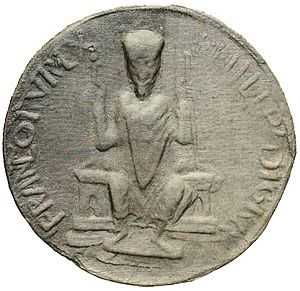Philip I of France facts for kids
Quick facts for kids Philip I |
|
|---|---|

Philip's effigy on his seal
|
|
| King of the Franks (more...) | |
| Co-reign Solo-reign |
23 May 1059 – 4 August 1060; 4 August 1060 – 29 July 1108 |
| Coronation | 23 May 1059 |
| Predecessor | Henry I |
| Successor | Louis VI |
| Regent | Anne of Kiev and Baldwin V of Flanders (1060–1067) |
| Born | 23 May 1052 Champagne-et-Fontaine |
| Died | 29 July 1108 (aged 56) Melun |
| Burial | Saint-Benoît-sur-Loire |
| Spouse | Bertha of Holland Bertrade de Montfort |
| Issue more... |
Constance, Princess of Antioch Louis VI of France Cecile, Princess of Galilee |
| House | Capet |
| Father | Henry I of France |
| Mother | Anne of Kiev |
Philip I (born May 23, 1052 – died July 29, 1108) was a powerful King of the Franks. He ruled from 1060 to 1108, which was a very long time for a king back then. Philip helped the French monarchy become stronger after a difficult period. He also added new lands, like the Vexin and Bourges, to the royal territory.
Contents
Early Life and Becoming King
Philip was born on May 23, 1052, in a place called Champagne-et-Fontaine. His father was King Henry I, and his mother was Anne of Kiev. It was unusual for someone in Western Europe at that time to have a Greek name, but his mother gave it to him.
Philip became king when he was only seven years old. Because he was so young, his mother, Queen Anne, acted as his regent. A regent is someone who rules for a child king until they are old enough. She was the first queen of France to ever do this! Baldwin V of Flanders also helped as a co-regent during this time.
Philip's Rule as King
When Baldwin VI of Flanders died, Robert the Frisian took control of Flanders. Baldwin's wife, Richilda, asked King Philip for help. However, Philip's army was defeated by Robert at the Battle of Cassel in 1071.
Philip first married Bertha of Holland in 1072. They had children, including an heir to the throne. Later, Philip married Bertrade de Montfort, who was already married to someone else. This caused a big problem with the church.
In 1094, Philip was excommunicated by a church leader named Hugh of Die. This meant he was temporarily cut off from the church. Pope Urban II repeated this excommunication in 1095. The ban was lifted a few times when Philip promised to leave Bertrade. But he always went back to her. Finally, in 1104, Philip publicly showed his regret. After this, he kept his relationship with Bertrade more private.
Philip also made an important appointment in 1060. He named Alberic as the first Constable of France. This was a high-ranking military position.
Like his father, Philip spent much of his reign dealing with powerful nobles. These nobles often rebelled against the king. In 1077, Philip made peace with William the Conqueror. William stopped trying to take over Brittany. Philip also expanded his kingdom. In 1082, he added the Vexin region to his lands. In 1100, he gained control of Bourges.
It was during Philip's reign that the First Crusade began. This was a major religious war. Philip did not personally join the Crusade because of his issues with Pope Urban II. However, his brother, Hugh of Vermandois, was an important leader in the First Crusade.
Death and Legacy
King Philip died on July 29, 1108, at the castle of Melun. He asked to be buried at the monastery of Saint-Benoît-sur-Loire. This was unusual because most French kings were buried in St Denis.
According to a writer named Abbot Suger, King Philip's health declined in his later years. He became less interested in running the country. However, people still respected and loved his son, Louis, who would become the next king. Philip was almost 60 years old when he passed away. He was succeeded by his son, Louis VI.
Children of Philip I
Philip had children with his first wife, Bertha:
- Constance (born 1078 – died 1126). She married Hugh I of Champagne and later Bohemund I of Antioch.
- Louis VI of France (born 1081 – died 1137). He became the next King of France.
- Henry (born 1083 – died young).
Philip also had children with Bertrade:
- Philip, Count of Mantes (born 1093 – active around 1123). He married Elizabeth.
- Fleury, Seigneur of Nangis (born 1095 – died 1119).
- Cecile (born 1097 – died 1145). She married Tancred, Prince of Galilee and later Pons of Tripoli.
See also
 In Spanish: Felipe I de Francia para niños
In Spanish: Felipe I de Francia para niños



